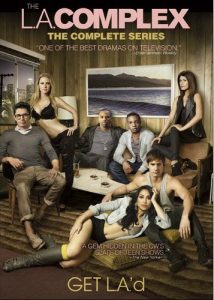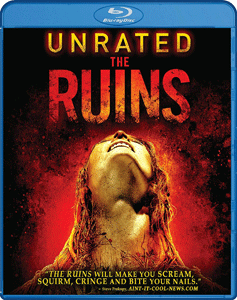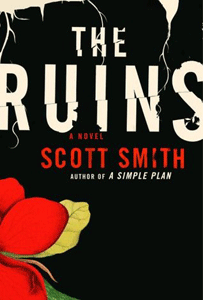On this re-read, I often flashed back to my first experience of Scott Smith’s “The Ruins” (2006). I vividly recalled details such as a dog whose feces moves because it’s so laced with parasites. And a debate over whether to amputate someone’s legs to possibly extend their life. And “Mayans” – as a present-day race of people – who act bizarrely. They try to stop tourists from climbing a hill, then force them to climb it.
THE BOOK
A day at the beach – at first
Smith (whose only previous novel was the masterful thriller “A Simple Plan”) was shaping up to be the next Thomas Harris: someone who writes very few novels, but wherein each one is a treat. Unfortunately, he’s gotten too extreme with the limited catalog; he hasn’t written a book since! (But he is the showrunner of TV’s “The Peripheral,” which I’m enjoying.)
Oh well, at least “The Ruins” stands as a strong example of how to write consistently intense horror, and how to balance grounded characterization within a bizarre but plausible sci-fi situation.

“The Ruins” (2006)
Author: Scott Smith
Genres: Horror, science fiction, thriller
Setting: Yucatan jungle, 2006
“The Ruins” starts safely away from the ruins, on the hot vacation beaches of the Yucatan, where four American college students are being generally immature and lazy. Their biggest concern is sunburn.
In a great line of characterization, alpha male Jeff reflects that he’s been a child for most of his life. That’s a rare perspective; Smith makes me realize we don’t rack up more adult years than child years until we’re in our 40s.
Yet the group – which has also acquired new friends in German Mathias and Greek “Pablo” (he gives himself a Mexican name while on vacay) — does look to Jeff because of his Eagle Scout background. Amy is his reliable but unassertive girlfriend, who looks after bestie “Spacey” Stacy. And Stacy’s “along for the ride” boyfriend Eric rounds out the bunch.
Another simple plan
As many films and novels have taught us, it’s never a good idea to venture into the jungles of Latin America unless you are seriously prepared. But Smith sets up the reason (Mathias’ brother is missing) and the naïve but understandable behavior of the sextet. (They think there’s an archeological dig going on. This remains a plot hole.)
The beachside resort is firmly in the civilized world; you wouldn’t think a day trip could take you wholly away from that. The air-conditioned bus ride is still civilized. The tourist town is less civilized, but amusingly so. The cab ride into the jungle seems vaguely dangerous, but there’s still room to joke around.
“The Ruins” reminds us – through gross details like that mutt in the primitive unmapped farming community — that not every spot on the globe in the 21st century is truly in what we think of as the 21st century.

Smith hits us with cultural clashes, language barriers and differences in what defines polite behavior. He makes us uneasy. And he still has the trump card up his sleeve.
Planting the horror (Spoilers)
(SPOILERS FOLLOW.)
I initially read “The Ruins” with mouth agape as Smith ascribes more and more sinister traits to the red-flowered vines on a hill in the middle of the jungle. I see the mechanics on closer inspection, but still, this is creatively chilling stuff.
The chill doesn’t leave you after closing the book, because we’re left to reflect on the brutally intelligent things the plant does to trick the tourists. It starts by faking a cellphone ring at the bottom of a well, for the sake of luring them to an injurious situation.
As always in “things get increasingly worse” stories, there are two possible outcomes: They get rescued, or they don’t. I saw both as equal possibilities.
Smith mildly includes “ticking clock” elements: They have a limited supply of food, and Pablo’s friends – “the Greeks” – might come for them. Yet the dominant progression in the narrative is the plant’s before-our-very-eyes evolution. Stuck in place by the lack of chapter breaks, we are trapped with the vines just like Jeff and friends are. (Sticking a bookmark in place only pauses the inevitable.)
This is how it would be. Your concerns become dead simple: How much food do we have left? Smith goes even more basic, though: These people are pushed beyond a survival situation into questioning their nature as humans – and humans’ position within nature.

THE MOVIE
Picking up the pace
Two years later, “The Ruins” became a movie – with Smith as the screenwriter, as was also the case on “A Simple Plan.” Director Carter Smith makes as good a movie as he can, considering it’s an almost comically fast-moving 90-minute adaptation of a long novel laced with details.
The cast is excellent, and seeing this group in person makes them more visceral. Jonathan Tucker, who is like an edgier Ethan Embry, plays a confident and competent Jeff. This enhances the intensity when even Jeff is overwhelmed.
Amy (always reliable Jena Malone) has the promiscuous traits of the book’s Stacy, and the film’s Stacy (Laura Ramsey, game for being put through the wringer) has the arc of the book’s Eric, fearing vines growing under her skin. This makes the women more robust than in the book.

“The Ruins” (2008)
Director: Carter Smith
Writer: Scott Smith, based on his own novel
Stars: Shawn Ashmore, Jena Malone, Jonathan Tucker
But Eric (Shawn Ashmore) and Mathias (Joe Anderson) are sacrificed to the film’s efficiency, with the latter getting Pablo’s novel arc. Pablo becomes Dimitri (Dimitri Baveas) in the movie, and he’s merely a plot point, albeit a shocking one.
Smart shorthand
If “The Ruins” was conceived as a B-movie romp from the start, then screenwriter Smith uses shorthand wisely. The hill morphs into a vine-covered pyramid, emphasizing the ancient Mayan setting. The lead Mayan is unique-looking Sergio Calderón, enhancing the otherworldly nature of this culture.
I don’t like how Smith ends the film, trying for a bit of hope and a bit of fatalism. It raises big questions about the future of the killer plant, then the credits roll under a rock song. Heck, “The Ruins” might as well answer the questions since we’re only at the 90-minute mark anyway.
Because the intensity hits quicker and faster, we miss the book’s undercurrent. Likely for ratings reasons, “The Ruins” shies away from most of its gore-horror opportunities – notably avoiding shocking visuals in the amputation sequence. (Granted, the unrated version perhaps shows more.)
Some moments are impressive, especially the girls’ adventure in the increasingly vine-encrusted mine shaft. Throw in closeups of the flowers mimicking sounds, and what could’ve been cheesy at least maintains the book’s plausibility. It all looks nice under the lens of Darius Khondji, who turns Australia into Mexico.
“The Ruins” is caught in the middle. It comes from a sober, detail-oriented horror novel, and it has a strong cast. But it’s too fast-moving for the fear to settle in. It’s rooted in its B-movie nature, perhaps inevitable when the villain is fast-growing vines.
Novel: 4.5 stars
Movie: 3.5 stars

